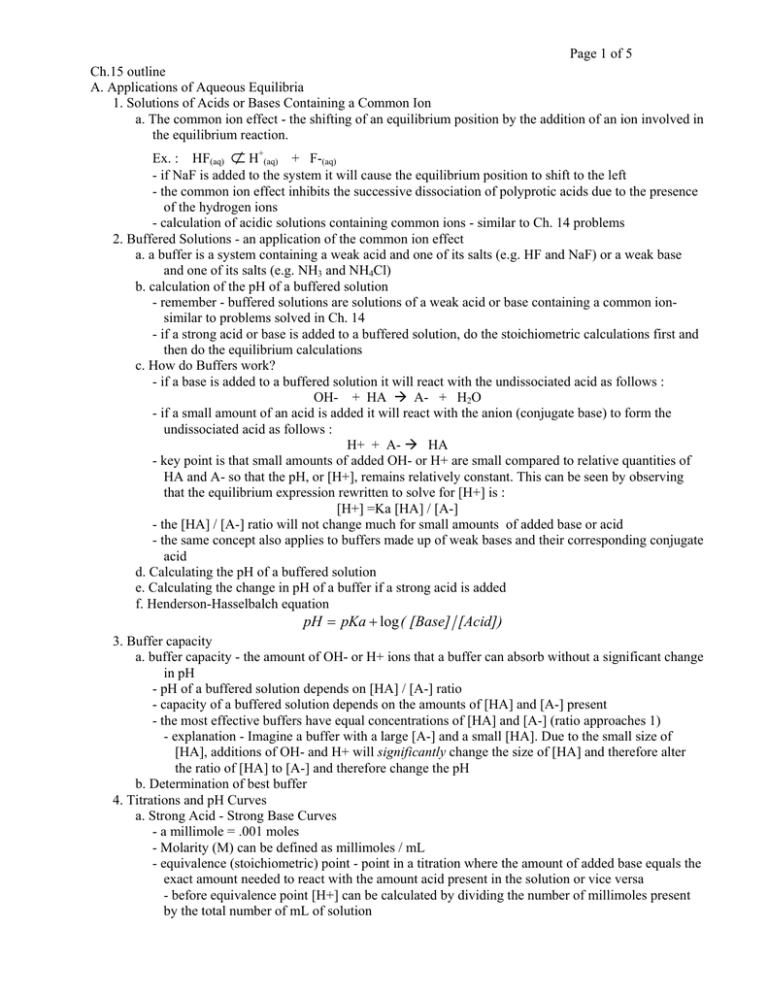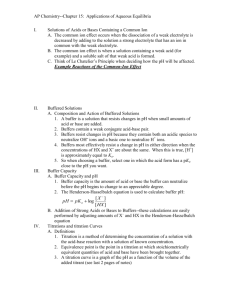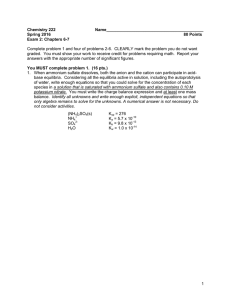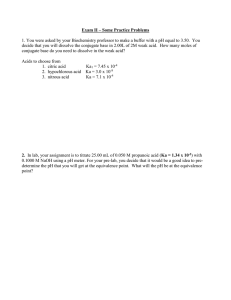Page 1 of 5 Ch.15 outline A. Applications of Aqueous Equilibria
advertisement

Page 1 of 5 Ch.15 outline A. Applications of Aqueous Equilibria 1. Solutions of Acids or Bases Containing a Common Ion a. The common ion effect - the shifting of an equilibrium position by the addition of an ion involved in the equilibrium reaction. Ex. : HF(aq) ⊄ H+(aq) + F-(aq) - if NaF is added to the system it will cause the equilibrium position to shift to the left - the common ion effect inhibits the successive dissociation of polyprotic acids due to the presence of the hydrogen ions - calculation of acidic solutions containing common ions - similar to Ch. 14 problems 2. Buffered Solutions - an application of the common ion effect a. a buffer is a system containing a weak acid and one of its salts (e.g. HF and NaF) or a weak base and one of its salts (e.g. NH3 and NH4Cl) b. calculation of the pH of a buffered solution - remember - buffered solutions are solutions of a weak acid or base containing a common ionsimilar to problems solved in Ch. 14 - if a strong acid or base is added to a buffered solution, do the stoichiometric calculations first and then do the equilibrium calculations c. How do Buffers work? - if a base is added to a buffered solution it will react with the undissociated acid as follows : OH- + HA Æ A- + H2O - if a small amount of an acid is added it will react with the anion (conjugate base) to form the undissociated acid as follows : H+ + A- Æ HA - key point is that small amounts of added OH- or H+ are small compared to relative quantities of HA and A- so that the pH, or [H+], remains relatively constant. This can be seen by observing that the equilibrium expression rewritten to solve for [H+] is : [H+] =Ka [HA] / [A-] - the [HA] / [A-] ratio will not change much for small amounts of added base or acid - the same concept also applies to buffers made up of weak bases and their corresponding conjugate acid d. Calculating the pH of a buffered solution e. Calculating the change in pH of a buffer if a strong acid is added f. Henderson-Hasselbalch equation pH = pKa + log ( [Base] [Acid]) 3. Buffer capacity a. buffer capacity - the amount of OH- or H+ ions that a buffer can absorb without a significant change in pH - pH of a buffered solution depends on [HA] / [A-] ratio - capacity of a buffered solution depends on the amounts of [HA] and [A-] present - the most effective buffers have equal concentrations of [HA] and [A-] (ratio approaches 1) - explanation - Imagine a buffer with a large [A-] and a small [HA]. Due to the small size of [HA], additions of OH- and H+ will significantly change the size of [HA] and therefore alter the ratio of [HA] to [A-] and therefore change the pH b. Determination of best buffer 4. Titrations and pH Curves a. Strong Acid - Strong Base Curves - a millimole = .001 moles - Molarity (M) can be defined as millimoles / mL - equivalence (stoichiometric) point - point in a titration where the amount of added base equals the exact amount needed to react with the amount acid present in the solution or vice versa - before equivalence point [H+] can be calculated by dividing the number of millimoles present by the total number of mL of solution Page 2 of 5 - pH = 7.00 at the equivalence point - After the equivalence point the [OH-] can be calculated by dividing the number millimoles of excess [OH-] by the total mL of the solution. [H+] can then be obtained from Kw. b. Titrations of weak acids with strong bases - must deal with the weak acid equilibrium - the weak acid will react to completion with the added base - Calculating the pH curve : - step 1 : stoichiometry - The OH- will react with the weak acid to completion and the concentrations of the remaining acid and conjugate base formed are determined - step 2- equilibrium problem - position of weak acid equilibrium is determined and the pH calculated -at the halfway point [H+] = Ka and pH = pKa - the pH at the equivalence point in a weak acid titration with a strong is always greater than 7 due to the anion of the acid (conjugate base) - the shape of the titration curve for strong and weak acids are the same after the equivalence point because the excess OH- controls the pH in this region - before equivalence point the pH rises sharply at first and then levels off(a buffered solution forms with optimal [HA] / [A-] ratio occurring halfway through the first part of the titration - note : in titration curves the equivalence point is determined by stoichiometry, not pH - it is the amount of acid or base present that determines the equivalence point, not strength - the strength of an acid or base will affect the pH at the equivalence point - the strength of a weak acid or base will affect the shape of a titration curve Fig 15.2, Zumdahl 4th ed., p. 728 Zumdahl 4th ed., p. 733 Fig 15.4, Zumdahl 4th ed., p. 735 Page 3 of 5 c. Calculation of Ka d. Titrations of weak bases with strong acids - similar to above 5. Acid-Base Indicators a. Two common methods to determine equivalence point - pH meter - an acid-base indicator - marks end point by a change in color - end point is the point of color change, not necessarily the equivalence point - an indicator should be chosen carefully so that the end point and equivalence points coincide - acid base indicators show one color when the proton is attached to the molecule and another when it is absent - consider phenolphthalein - clear in acidic solutions and pink in basic solutions (we'll call it Clear In) : HIn(aq) ⊄ Pink H+(aq) + In-(aq) - for above Ka = [H+][In-] / [HIn] - for most indicators about one-tenth of the original form must be converted in order for a color change to occur and therefore the pH will change when [In-] / [Hin] = 1 / 10 - the color transition occurs over a pH range given by pKa 1 - for strong acid-base titrations there will be a lot of flexibility choosing an indicator because pH changes so rapidly near the end point (color change will occur with the addition of a single drop giving good precision) -for weak acid titrations there is less room for error and the indicator must be chosen more carefully (midpoint of color change should coincide with equivalence point) 6. Solubility Equilibria and the Solubility Product a. solubility product constant (Ksp) - product of ion concentrations at equilibrium - e.g. for CaF2 at equilibrium : CaF2(aq) ⊄ Ca2+(aq) + 2F-(aq) - Ksp expression is Ksp = [Ca2+][F-]2 (CaF2 is a pure solid and is therefore not include in the equilibrium expression) - Ksp is a constant and has only one value at a given temperature - solubility is an equilibrium position b. calculation of Ksp from solubility c. calculation of solubility from Ksp d. relative solubilities - if salts have the same number of ions their solubilities can be compared directly - if salts have differing numbers of ions in solution they cannot be compared directly e.g. Ksp expression for AgI : Ksp = [Ag+][I-] Ksp expression for Ag2S : Ksp = [Ag]2[S] e. Common Ion Effect calculations f. pH and solubility - hydroxides become less soluble if OH- ions are added from another source - silver phosphate becomes more soluble in acidic solutions : Ag3PO4(s) ⊄ 3 Ag+(aq) + PO43-(aq) - increased solubility is due to the phosphate ions combining with hydrogen ions to form the hydrogen phosphate ion (HPO42-) which decreases the phosphate ion concentration causing the equilibrium position to shift to the right - general rule : if an anion, X-, is an effective base (HX is a weak acid), the salt MX will show an increased solubility in an acidic solution 7. Precipitation and Qualitative Analysis a. if the ion product quotient (Q) for the initial concentrations (not equilibrium) exceeds the Ksp value a precipitate will occur Page 4 of 5 2+ 2 - e.g. for CaF2 : Q = [Ca ]0[F-]0 if Q > Ksp then a precipitate will form and vice versa b. Calculation of precipitation reactions c. selective precipitation - the use of relative solubilities to separate mixtures of ions by precipitation - the sulfide ion is basic so its concentration can be controlled by controlling pH meaning the most insoluble sulfide salts can be precipitated out in acidic solutions leaving the more soluble salts. The more soluble salts can then be precipitated out by making the solution more basic. d. qualitative analysis- a scheme to separate mixtures of ions - Group I - insoluble chlorides - Group II - sulfides insoluble in acidic solution - Group III - sulfides insoluble in basic solution - Group IV - insoluble carbonates - Group V - alkali metal and ammonium ions 8. Complex ion equilibria a. A complex ion is a charged species consisting of a metallic ion surrounded by ligands. - ligand - a Lewis base Page 5 of 5 - coordination number - the number of ligands attached to a metallic ion - 6, 4 and 2 are the most common coordination numbers (others exist) - examples include Co(H2O)62+, Ni(NH3)62+, Cu(NH3)42+, Ag(NH3)2+ - ligands are added one at a time in steps characterized by formation (stability) constants b. Complex ions and Solubility - water-insoluble salts can be dissolved by - acidifying the solution if the anion is a good base - adding a ligand that forms a stable, soluble complex with the metallic ion of the salt -e.g. HgS (Ksp = 10-54) is very insoluble in water, but will dissolve in aqua regia (a mixture of concentrated HCl and concentrated HNO3) -increasing the temperature of the water









